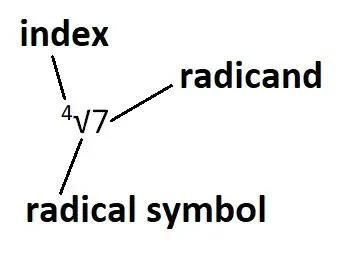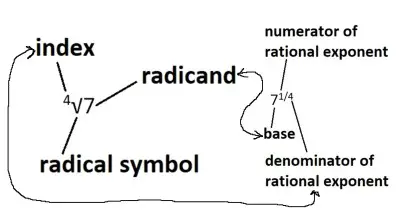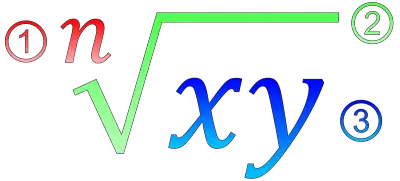When you work with radicals, you need to know the various parts and how they affect the value of the radical. For example, the radicand is important, and we also need to understand the index.
So, what is the index of a radicand? The index is the number to the upper left of a radical symbol, and it tells us which root of the radicand to take. For example, an index of 2 means a square root, an index of 3 means a cube root, and so forth. Depending on the radicand and index, we may get real, pure imaginary, or complex roots.
Of course, we can also convert a radical to a term with a rational exponent by using the radicand as the base and the index as the denominator of the rational exponent.
In this article, we’ll talk about the index of a radical, including what it is and what values it can take on. We will also give some examples to show the various cases, to get a better grasp on the concept of the index of a radical.
Let’s get started.
What Is The Index Of A Radical?
The index of a radical is the number or expression to the upper left of a radical symbol. For the radical n√x, we say that n is the index and x is the radicand.

The radicand is the value we are taking a root of. For the radical n√x, we say that we are taking “the nth root of x.”
So, the index tells us whether to take the square root (n = 2), cube root (n = 3), fourth root (n = 4), or another root of a radicand.
The value of the index, along with the radicand, will tell us the type of number we get as a result. We may get:
- real numbers, such as √9 = 3
- pure imaginary numbers, such as √(-4) = 2i
- complex numbers, such as 4√(-64) = 2 – 2i
How To Convert Radical To Exponential Form
Remember that there is also a way to convert between radicals and terms with rational exponents. Remember that:
- n√x = x1/n
Note that the radicand, x, from the left side of the equation becomes the base of the term on the right side of the equation.
Also, the index n from the left side of the equation becomes the denominator of the rational exponent on the right side of the equation.
Here is a more general formula that comes from the previous one:
- n√(xm) = xm/n

Example 1: Converting Radical To Exponential Form
Consider the radical 3√7. The index is n = 3 and the radicand is x = 7.
Using the first formula above to convert to exponential form gives us:
- n√x = x1/n [formula to convert radical to exponential]
- 3√7 = 71/3 [substitute x = 7 and n = 3]
So, 71/3 is the exponential form (term with a rational exponent) that is equivalent to the radical 3√7.
Example 2: Converting Radical To Exponential Form
Consider the radical 4√(62). The index is n = 4 and the radicand is x = 6, with an exponent of m = 2.
Using the second formula above to convert to exponential form gives us:
- n√(xm) = xm/n [formula to convert radical to exponential]
- 4√(62) = 62/4 [substitute x = 6, m = 2, and n = 4]
- 4√(62) = 62/4
So, 62/4 is the exponential form (term with a rational exponent) that is equivalent to the radical 4√(62).
Note that we can further reduce the exponent 2/4 to 1/2, which means that 4√(62) is equivalent to 61/2 or √6.
Now let’s look at how to find the index of a radical and how to reduce it if necessary.
How Do You Find The Index Of A Radical?
To find the index of a radical, look for the number to the upper left of the radical symbol.

If there is no number to the upper left of the radical symbol, we assume an index of 2 (a square root) by default.
For example:
- The radical 3√5 has an index of 3 (since 3 is the number to the upper left of the radical symbol).
- The radical 4√2 has an index of 4 (since 4 is the number to the upper left of the radical symbol).
- The radical 5√7 has an index of 5 (since 5 is the number to the upper left of the radical symbol).
- The radical √3 has an index of 2 (since there is no number to the upper left of the radical symbol, so we assume an index of 2 by default).
If you have the exponential form xm/n, you can still find the index of the corresponding radical:
First, reduce the rational exponent m/n as much as possible (here, we will assume m/n is reduced).
Now, take the denominator n – this is the index of the corresponding radical.
To write the radical, follow these extra steps:
Take xm – this is the radicand of the corresponding radical.
Write the radical as n√(xm).
Thus, xm/n is equivalent to n√(xm).
What Is The Index Of A Radical When It Is Not Written In The Expression?
As mentioned above, the index of a radical is assumed to be 2 when there is no index written in the expression. This is due to the fact that a square root (with an index of n = 2) is the most common root we would take.

So, we leave out the index of 2 as shorthand (although, you can write it if you wish).
That is, √x = 2√x.
How Do You Reduce The Index Of A Radical?
To reduce the index of a radical, we take these steps:
- 1. Convert the radical to exponential form with a rational exponent (using the formula from earlier).
- 2. Reduce the rational exponent (a fraction) as much as possible.
- 3. If necessary, convert the resulting exponential form back to radical form (using the same formula from earlier).
Let’s look at some examples of how this would work.
Example 1: Reducing The Index Of A Radical
Let’s say we have the radical 3√(56).
The index is n = 3 and the radicand is x = 5, with an exponent of m = 6.
Using the formula above to convert to exponential form gives us:
- n√(xm) = xm/n [formula to convert radical to exponential]
- 3√(56) = 56/3 [substitute x = 5, m = 6, and n = 3]
- 3√(56) = 52
- 3√(56) = 25
So, 25 is the simplified form (term with a rational exponent) that is equivalent to the radical 3√(56).
Note that we do not need to convert 25 back to a radical form, since the rational exponent is a whole number (25 = 251 or 25 = 52).
Example 2: Reducing The Index Of A Radical
Let’s say we have the radical 4√(210).
The index is n = 4 and the radicand is x = 2, with an exponent of m = 10
Using the formula above to convert to exponential form gives us:
- n√(xm) = xm/n [formula to convert radical to exponential]
- 4√(210) = 210/4 [substitute x = x, m = 10, and n = 4]
- 4√(210) = 25/2 [reduced 10/4 to 5/2]
So, 25/2 is the simplified form (term with a rational exponent) that is equivalent to the radical 4√(210).
Note that we can simplify 25/2 as follows:
- 25/2
- =(25)1/2
- =321/2
To convert 25 back to a radical form, we use the formula from before:
- n√(x) = x1/n [formula to convert exponential to radical]
- 2√(32) = 321/2 [substitute x = 32 and n = 2]
So, the radical 4√(210) reduces to the radical 2√(32).
Can The Index Of A Radical Be Negative?
Usually, we restrict the value of an index to the natural numbers (that is, positive whole numbers like n = 1, 2, 3, etc.)
However, if we think of a radical as the solution to an equation, then we can see how to define a negative radical.
For example:
- √5 is a solution to the equation x2 = 5.
- 3√5 is a solution to the equation x3 = 5.
- 4√5 is a solution to the equation x4 = 5.
- etc.
So, for a negative index:
- -1√5 is the solution to the equation x-1 = 5 (that is, x = 1 / 5).
- -2√5 is the solution to the equation x-2 = 5 (that is, x = 1 / √5).
- -3√5 is the solution to the equation x-3 = 5 (that is, x = 1 / 3√5).
Conclusion
Now you know a little more about the index of a radical: what it is, when it is used, and how it relates to the radicand of a radical.
You can learn more about the radicand (and what it means) here.
You can learn all about radical equations here.
I hope you found this article helpful. If so, please share it with someone who can use the information.
Don’t forget to subscribe to our YouTube channel & get updates on new math videos!


